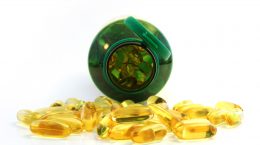Published on July 14, 2022
Video Friday: Is your Omega-3 Index not increasing with increased doses of fish oils? The type of fish oil supplement you are taking may be the culprit!
Key Points
- Not all supplements are created equal; in some cases, participants have noticed that increasing their dose of omega-3s DHA and EPA did not result in an expected increase in omega-3 status, as measured by their Omega-3 Index
- Looking for the triglyceride form of fish oils in supplements is important for better absorption, however, many products formulated to have increased concentrations of EPA and/or DHA may actually be in the form of ethyl esters due to processing of the fish oils in the supplement; unfortunately, not all supplements include this information on their label
- It is up to 5 times more difficult for your small intestine to break down and absorb the ethyl ester form than the triglyceride form, making it important to measure your omega-3 status!
 EPA (eicosapentaenoic acid) and DHA (docosahexaenoic acid) are two very important omega-3 fatty acids found in fatty fish and other marine sources which are essential to our health. Omega-3s help mediate the immune response, balance the innate and adaptive immune systems, and are anti-inflammatory. Higher levels of omega-3s have been associated with improved cognitive function and cardiovascular health, lower risk of dementia, lower risk of cancer, longer life, and a reduced relative risk for death from any cause, including COVID-19. In fact, the authors of a recent study concluded that “an Omega-3 Index greater than 6.6%, and possibly as high as 8.5%, is associated with lower NLR values that are indicative of a quiescent, balanced innate-adaptive immune system,” which in turn, helps lower the risk of severe COVID-19.
EPA (eicosapentaenoic acid) and DHA (docosahexaenoic acid) are two very important omega-3 fatty acids found in fatty fish and other marine sources which are essential to our health. Omega-3s help mediate the immune response, balance the innate and adaptive immune systems, and are anti-inflammatory. Higher levels of omega-3s have been associated with improved cognitive function and cardiovascular health, lower risk of dementia, lower risk of cancer, longer life, and a reduced relative risk for death from any cause, including COVID-19. In fact, the authors of a recent study concluded that “an Omega-3 Index greater than 6.6%, and possibly as high as 8.5%, is associated with lower NLR values that are indicative of a quiescent, balanced innate-adaptive immune system,” which in turn, helps lower the risk of severe COVID-19.
It is because of these health benefits that many individuals take an omega-3 supplement. Unfortunately, not all supplements are created equal, and in some cases, increasing the dose of omega-3s DHA and EPA may not result in an increase in omega-3 status, as measured by the Omega-3 Index.
Quality supplements tend to cost more, so how can you tell if you are getting what you pay for?
Are You Paying More for a Less Absorbable Form of Fish Oil? Which Form to Look for in Your Fish Oil Supplements
The following video, presented by National Nutrition Canada with leading health expert Karlene Karst, reviews the difference between two different forms of fish oils found in supplements – Triglyceride and Ethyl Ester. Looking for the triglyceride form of fish oils is important for better absorption, however, many products formulated to have increased concentrations of EPA and/or DHA may actually be in the form of ethyl esters due to processing of the fish oils in the supplement. Some brands include an additional step that converts the fish oils back to the triglyceride form, which is much more easily absorbed and utilized, and which therefore is more effective at raising the Omega-3 Index.
Watch the Video to Learn More
After watching, be sure to make note of the details below.
Video Summary: Fish Oil Supplements: Fish Oil Triglyceride Vs. Ethyl Esters – Professional Supplement Review
Fish oils are a great source of omega-3s EPA (known to reduce inflammation) and DHA (known to promote hormone health)
The extraction method used to purify fish oil can produce two different forms of product. One is the naturally occurring triglyceride form (TG), while the other is the ethyl ester form (EE)
Fish oils in their natural state come in the form of triglycerides, the state in which fats are carried and stored in the body. This is also the form that is better absorbed and utilized.
When a product is labeled high in DHA or high in EPA, it can indicate that the fish oils have been through a distillation process that converts them into ethyl esters, which are less absorbed
*It is up to 5 times more difficult for your small intestine to break down and absorb the ethyl ester form than the triglyceride form
Some supplement companies convert the ethyl ester form back into the triglyceride form, which can be more costly but will also be better absorbed
Usually the triglyceride forms are labeled as such, however, there is no regulation about disclosing the form of omega-3s in the supplement. Look on your fish oil supplement to make sure it specifically says “Triglyceride Form.”
Are You Absorbing Enough Omega-3s from Your Supplement?
The Omega-3 Index is a blood test used to measure the amount of EPA and DHA in red blood cell (RBC) membranes and is expressed as a percent of total RBC fatty acids. It is an excellent indicator of how much omega-3 fatty acids are being absorbed and utilized within the cells and tissues. A higher Omega-3 Index is associated with a higher omega-3 status, lower levels of chronic inflammation, and better health outcomes. For example, an Omega-3 Index of over 8% is associated with the lowest risk of death from heart disease and below 4% with the highest.
As part of your GrassrootsHealth home blood spot test, you can choose to measure your Omega-3 Index along with your vitamin D. Scientists recommend a target Omega-3 Index of 8% or higher. Testing is essential, as there is a large amount of variability in the omega-3 status for different people with the same intake amount (similar to vitamin D!). For example, a GrassrootsHealth analysis showed that the range of response with 1000 mg of EPA+DHA per day was 5.7% to 10.2% – one factor contributing this being the form of omega-3s in your supplements. Therefore, it is recommended that individuals measure their Omega-3 Index and determine a personalized dose using the Omega-3 calculator to achieve a minimum Omega-3 Index of 8%.
Measure Your Omega-3 Levels to Make Sure You are Getting Enough
Have you measured your Omega-3 Index? Add it to your custom home test kit today!






